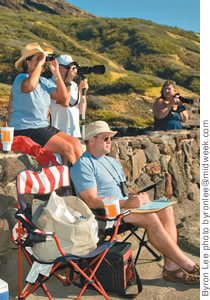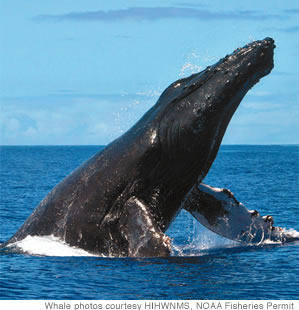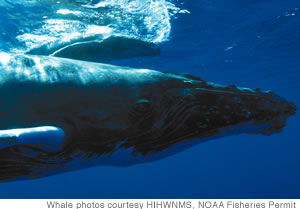Thar She Blows!
MidWeek’s swashbuckling reporter joins the annual whale count and spouts off about it. At the start of each year, the National Oceanic and Atmospheric Administration’s (NOAA) Hawaiian Islands Humpback Whale National Marine Sanctuary (HIHWNMS) holds an Ocean Count project.

By .(JavaScript must be enabled to view this email address)
E-mail this story | Print this page | Archive | RSS

|
Call me Ishmael. Well, no, don’t literally call me Ishmael. But good stories about whales usually start that way, so go with me on this.
My tale starts along the same lines as the Herman Melville classic - having little money in my purse and not much to do on shore, I decided to join up with a band of sea lovers and hunt some whale.
But unlike Captain Ahab and his surly crew, we were not on the lookout for a crazed, leg-eating, white sperm whale. We were craning the horizon for the telltale spurt that signaled a pod of humpbacks was on the move.
At the start of each year, the National Oceanic and Atmospheric Administration’s (NOAA) Hawaiian Islands Humpback Whale National Marine Sanctuary (HIHWNMS) holds an Ocean Count project. Hundreds of volunteers squat at nearly 60 sites around Oahu, Kauai, the Big Island and Kahoolawe to take part in this annual shore-based humpback whale survey. Over time, data from the count can be used to corroborate scientific studies on the breeding and migration habits for approximately two-thirds of the North Pacific humpback population.
“The Ocean Count project provides a unique opportunity for the public to learn about Hawaii’s humpbacks while participating in a monitoring effort,” says Christine Brammer, Ocean Count coordinator with the sanctuary. “Many volunteers who try out the project come back year after year. It is easy to get hooked on watching Hawaii’s humpbacks.”
One veteran whale-watcher I met during the first count of the season was June Kawamata. Driving out to Lanai Lookout the last morning of January, the stark change in weather was a happy omen. The sun shone warmly on my shoulders upon my meeting with the equally welcoming site manager. After brief pleasantries, a cry interrupts our conversation.
“That’s one blow! And there’s another; looks like a calf,” calls out one of the volunteers.
“If you see a big blow, you know that’s an adult, and usually if it’s a female, the baby’s nearby mama,” Kawamata explains how to properly track the creatures.
The former school lunch supervisor has been managing this post since the Ocean Count began 13 years ago. But she says her passion for whales started in 1990 after a student at Kailua High School told her of a trip the marine science class had taken to the Makapuu Lookout.
“One night my daughter, her friend, my son and I rode over to Makapuu and we climbed the hillside. We sat on the cliff and, lo and behold, I saw sprays. And I thought, ‘Wow. That’s something interesting.’ It’s really amazing,” she says, her eyes steeped in that memory as more cheers erupt at the sight of a series of tail slaps and a breach.
One of the best ways to learn about these creatures of the deep is to set your sights on the open seas and take part in the sanctuary’s next Ocean Count Feb. 28. Volunteers will be given a quick tutorial on how to track a whale and what behaviors to look for. Then, from 8 a.m. to 12:15 p.m., it’s nothing but you, your mates and the sea.

“You get spoiled,” attests Kawamata, pointing to the spot that made headlines last year when President Barack Obama scattered his grandmother’s ashes into the sea. “When we see the whales come in, usually the biggest and most curious come to this cove no more than 10 feet off the point there,”
“There was a mother and a baby here about three weeks ago, and they were here for an hour,” says Bob Ubersax, who has been hooked on whales since moving to Hawaii Kai eight years ago. “People were running down to the lower level there to take pictures and they were right at eye-level with the baby breaching. It was real exciting.
“They’re such intelligent creatures. Their behaviors are interesting to watch, and you don’t know what makes them do what they do. You’re always hoping to come down and see something new.”
Sometimes that something new includes other marine life.
“When it’s slow, we look for birds, we look for turtles, monk seals, submarines, kayakers ... anything to keep us amused,” Ubersax adds. “There’s a chicken that hangs out here, too. We call him Chucky. Another thing about whale watching, you meet a lot of nice people. Lot of interesting people, too, from all walks of life.”
“They come here almost every weekend during whale season; they call them their ‘pod,’” Brammer laughs.
This season’s last count will be conducted March 28. To join a crew at one of the selected Oahu sites, call 397-2651, ext. 253.
Can’t make either count? Gov. Linda Lingle and Lt. Gov. Duke Aiona proclaimed February 2009 Humpback Whale Month, and to celebrate HIHWNMS is hosting a slew of special programs for the public. Keiki can get aboard, too, and become official members of the Ocean Guardian Kids Club by entering the 2009 Humpback Whale Month Ocean Contest by March 4. For a full list of events and information, visit http://hawaiihumpbackwhale.noaa.gov.

“You get a little disappointed at the end of the season when there’s nothing to do for six months,” Brammer confesses.
But there certainly is a lot of be seen before the summer-autumn lull hits. Participants tallied an average of eight whales per site statewide, making for an average of four whales off Oahu shores, Kauai seeing eight, the Big Island with five, and Kahoolawe counting the most at 14 whales.
“It doesn’t really mean much to just look at it for one day, but if you look at it over time, when you’re doing it the same days each year, you can see trends in whale behavior,” Brammer says of what this data means. And she assures that the seemingly low numbers are nothing to snub your nose at. Combined with aerial surveys and boat research by NOAA, the Ocean Count has corroborated the increase of the humpback population around the Hawaiian Islands.
“Increase is about 7 percent each year. As the population has increased, they have started to go to different areas of the Islands more commonly.”
For example, Brammer says that around the Big Island, whales would usually be spotted on the Kohala/Kona side. As the population has grown, more and more can been seen off of Hilo.
“A lot of people ask when will they be taken off the (U.S. Fish & Wildlife Service’s Endangered Species Program) list, because we keep saying that the population is recovering, but I don’t really know what that magic number would be,” says Brammer. “But we have found out that the original estimates of whales we thought were in existence in the North Pacific were probably grossly underestimated.”
The first population guesswork came from records whalers kept of their kills in the early 20th century. Brammer says the initial count came to 15,000-20,000 animals in the North Pacific, while worldwide data suggests a total pre-whaling population of 125,000.
Compare those numbers to the 1,500 animals found before the International Whaling Commission introduced a ban on commercial humpback whaling in 1966.
The humpback was listed as an endangered species four years later, and today Brammer says the whale population in the Pacific is back up to 10,000-12,000 animals (18,000-20,000 worldwide).
Two recent beached calves on Kauai show threats still abound for this gentle giant. The most common: Vehicle-whale collisions, entanglement in fishing gear, climate change and habitat degradation, and acoustic disturbances. Visit HIHWNMS’s website or nmsfocean.org for ways on how to support their Kohola Campaign.
“The whales are here in Hawaii during the winter, but then they go elsewhere. We need to be able to protect them everywhere they’re going,” says Brammer of what the sanctuary has mapped out for future projects.
“We’re trying to work with other marine animal protected areas to better understand those issues and work together. We’d always like to do more.”
And so here ends my adventure. But unlike Ishmael, my tale did not contain a fathom of drama - lest you count the sight of a 50-ton creature launching itself sky-ward in a dazzling display of froth, flukes and barnacles before returning to the depths of Davy Jones’ locker.
Now thar’s the makings of a great story.
Page 1 of 1 pages for this story
E-mail this story | Print this page | Comments (0) | Archive | RSS
Most Recent Comment(s):








